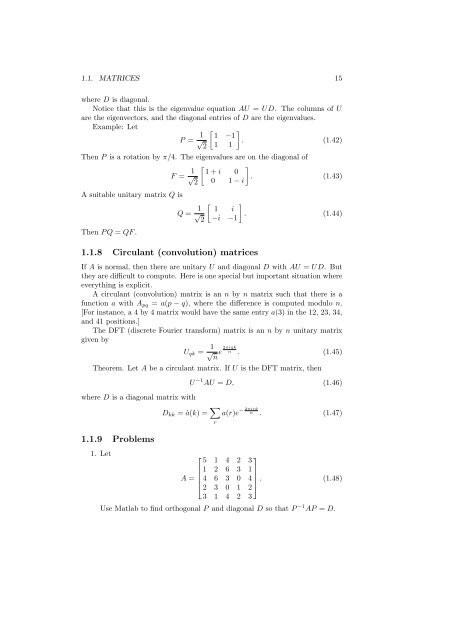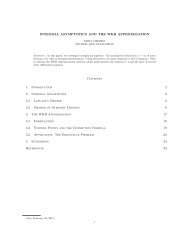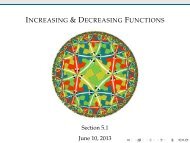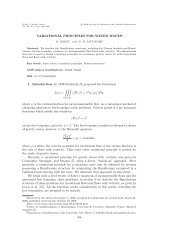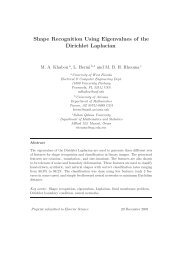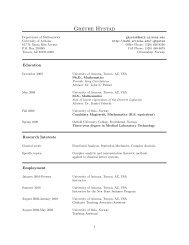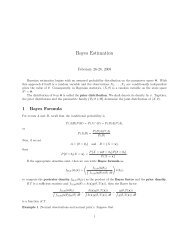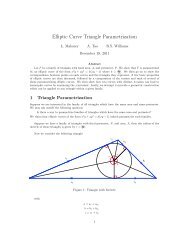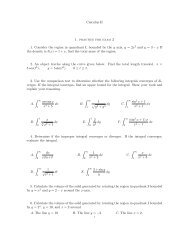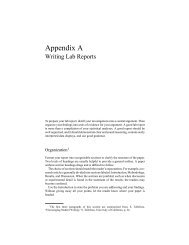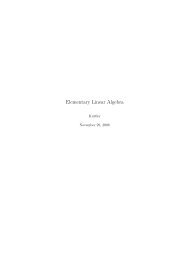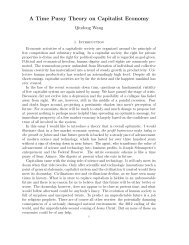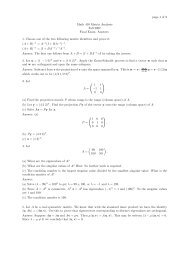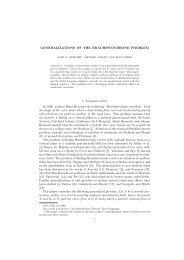- Page 1: Methods of Applied MathematicsLectu
- Page 4 and 5: 4 CONTENTS2 Fourier series 372.1 Or
- Page 6 and 7: 6 CONTENTS8 Normal operators 1058.1
- Page 8 and 9: 8 CHAPTER 1. LINEAR ALGEBRAand the
- Page 10 and 11: 10 CHAPTER 1. LINEAR ALGEBRAThe nul
- Page 12 and 13: 12 CHAPTER 1. LINEAR ALGEBRAThe N k
- Page 16 and 17: 16 CHAPTER 1. LINEAR ALGEBRA2. Find
- Page 18 and 19: 18 CHAPTER 1. LINEAR ALGEBRA1.2.2 L
- Page 20 and 21: 20 CHAPTER 1. LINEAR ALGEBRAWe thin
- Page 22 and 23: 22 CHAPTER 1. LINEAR ALGEBRAand √
- Page 24 and 25: 24 CHAPTER 1. LINEAR ALGEBRAWe can
- Page 26 and 27: 26 CHAPTER 1. LINEAR ALGEBRAanddv =
- Page 28 and 29: 28 CHAPTER 1. LINEAR ALGEBRATheorem
- Page 30 and 31: 30 CHAPTER 1. LINEAR ALGEBRAwhere
- Page 32 and 33: 32 CHAPTER 1. LINEAR ALGEBRAIn this
- Page 34 and 35: 34 CHAPTER 1. LINEAR ALGEBRASo they
- Page 36 and 37: 36 CHAPTER 1. LINEAR ALGEBRAChange
- Page 38 and 39: 38 CHAPTER 2. FOURIER SERIESIn part
- Page 40 and 41: 40 CHAPTER 2. FOURIER SERIESThus‖
- Page 42 and 43: 42 CHAPTER 2. FOURIER SERIESNote th
- Page 44 and 45: 44 CHAPTER 2. FOURIER SERIES
- Page 46 and 47: 46 CHAPTER 3. FOURIER TRANSFORMSWe
- Page 48 and 49: 48 CHAPTER 3. FOURIER TRANSFORMS(Ri
- Page 50 and 51: 50 CHAPTER 3. FOURIER TRANSFORMS3.7
- Page 52 and 53: 52 CHAPTER 3. FOURIER TRANSFORMS4.
- Page 54 and 55: 54 CHAPTER 4. COMPLEX INTEGRATION4.
- Page 56 and 57: 56 CHAPTER 4. COMPLEX INTEGRATIONEx
- Page 58 and 59: 58 CHAPTER 4. COMPLEX INTEGRATION4.
- Page 60 and 61: 60 CHAPTER 4. COMPLEX INTEGRATION2.
- Page 62 and 63: 62 CHAPTER 4. COMPLEX INTEGRATION4.
- Page 64 and 65:
64 CHAPTER 4. COMPLEX INTEGRATIONBu
- Page 66 and 67:
66 CHAPTER 4. COMPLEX INTEGRATION
- Page 68 and 69:
68 CHAPTER 5. DISTRIBUTIONSin that
- Page 70 and 71:
70 CHAPTER 5. DISTRIBUTIONS5.3 Rado
- Page 72 and 73:
72 CHAPTER 5. DISTRIBUTIONS7. Take
- Page 74 and 75:
74 CHAPTER 5. DISTRIBUTIONS5.7 Pois
- Page 76 and 77:
76 CHAPTER 5. DISTRIBUTIONSIt says
- Page 78 and 79:
78 CHAPTER 5. DISTRIBUTIONSand its
- Page 80 and 81:
80 CHAPTER 5. DISTRIBUTIONSSince th
- Page 82 and 83:
82 CHAPTER 6. BOUNDED OPERATORSIt i
- Page 84:
84 CHAPTER 6. BOUNDED OPERATORSExam
- Page 87 and 88:
6.4. HILBERT-SCHMIDT OPERATORS 87Th
- Page 89 and 90:
6.6. FINITE RANK OPERATORS 895. Let
- Page 91 and 92:
6.7. PROBLEMS 914. Consider functio
- Page 93 and 94:
Chapter 7Densely Defined ClosedOper
- Page 95 and 96:
7.4. OPERATORS 95Corollary. R(L) =
- Page 97 and 98:
7.7. PROBLEMS 977.7 ProblemsIf K is
- Page 99 and 100:
7.9. FIRST ORDER DIFFERENTIAL OPERA
- Page 101 and 102:
7.11. GENERATING SECOND-ORDER SELF-
- Page 103 and 104:
7.14. PROBLEMS 103Example: Let H be
- Page 105 and 106:
Chapter 8Normal operators8.1 Spectr
- Page 107 and 108:
8.3. VARIATION OF PARAMETERS AND GR
- Page 109 and 110:
8.5. SECOND ORDER DIFFERENTIAL OPER
- Page 111 and 112:
8.7. THE SPECTRAL THEOREM FOR NORMA
- Page 113 and 114:
8.10. EXAMPLES: SCHRÖDINGER OPERAT
- Page 115 and 116:
8.11. SUBNORMAL OPERATORS 115plane.
- Page 117 and 118:
8.12. EXAMPLES: FORWARD TRANSLATION
- Page 119 and 120:
8.14. PROBLEMS 119If we assume that
- Page 121 and 122:
Chapter 9Calculus of Variations9.1
- Page 123 and 124:
9.3. SECOND VARIATION 123Example 1:
- Page 125 and 126:
9.4. INTERLUDE: THE LEGENDRE TRANSF
- Page 127 and 128:
9.6. HAMILTONIAN MECHANICS 127Defin
- Page 129 and 130:
9.8. PROBLEMS 1299.8 ProblemsLet L
- Page 131 and 132:
9.10. APPENDIX: LAGRANGE MULTIPLIER
- Page 133 and 134:
Chapter 10Perturbation theory10.1 T
- Page 135 and 136:
10.2. PROBLEMS 135So the expansion
- Page 137 and 138:
10.4. NONLINEAR DIFFERENTIAL EQUATI
- Page 139 and 140:
10.6. EIGENVALUES AND EIGENVECTORS
- Page 141 and 142:
10.7. THE SELF-ADJOINT CASE 141Henc
- Page 143:
10.8. THE ANHARMONIC OSCILLATOR 143


